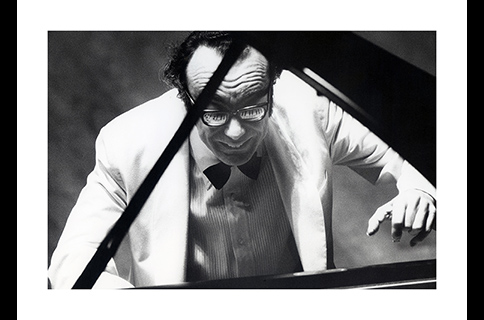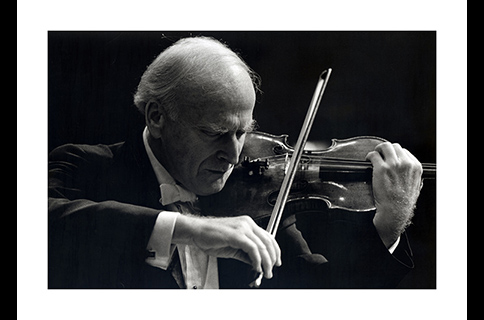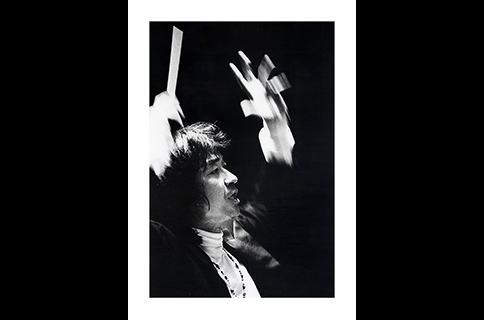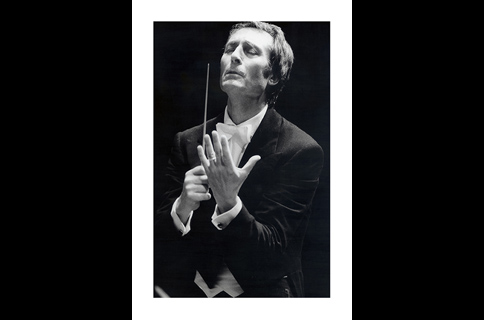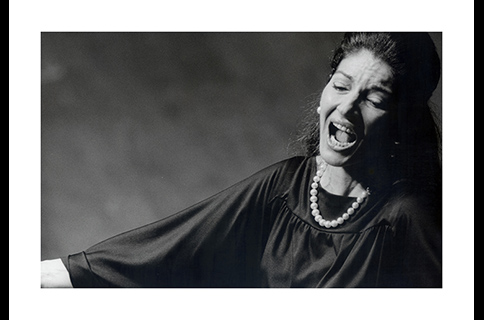- Home
- Exhibitions & Events
- Photographs Making Music Akira Kinoshita: Musicians of the World
FUJIFILM SQUARE Photo History Museum Exhibition
Photographs Making Music
Akira Kinoshita: Musicians of the World
The FUJIFILM SQUARE Photo History Museum is pleased to present an exhibition of works by Akira Kinoshita, a specialist in music photography. The exhibition will run from October 1 to December 28, 2020.
Starting in the 1960s and continuing for about half a century, Akira Kinoshita (1936-2015) depicted the world of music in photographs. A pioneer of the unexplored genre of music photography, as well as its leading proponent working in Japan and overseas, Kinoshita photographed many distinguished musicians including Herbert von Karajan, Maria Callas, and Seiji Ozawa. Praised for “hearing music in them,” his works have been acclaimed by both photographic and music circles in Japan and internationally.
Kinoshita was born in Suwa, Nagano Prefecture in 1936. His first exposure to the world of photography was as a child watching his father, a newspaper reporter, at work in the darkroom. A keen mountain climber during his school days, Kinoshita's first encounter with classical music came in a mountain hut. Later, while working in the photo-processing department at Chunichi Shimbun and then as a photographer at Hakuhodo, Kinoshita deepened his knowledge of music and established the unique form of photographic expression that became music photography. In 1973, Kinoshita started to work as a freelance photographer.
The main topic of Kinoshita's photography was always music, but within that genre he covered a wide range of themes. Whether taking behind-the-scenes photographs of musicians, capturing magnificent opera houses and theaters worldwide, or journeying in the footsteps of composers, his diverse photographs give expression to the world of music. But it is arguably the photographs of musicians in performance that show Kinoshita at his best. Capturing the dynamic movements of bold conductors, or the delicate moments of emotional performers, his photographs are admired by many musicians as rarities that express their soul and philosophy, even the essence of the music. As a result, Kinoshita received a great number of requests for photographs. Miraculous gifts born out of the strong bond with the musicians who were his subjects, the photographs are the result of Kinoshita's insatiable enthusiasm for photography, his rich sensibility, and his deep understanding of music.
Among his many masterpieces of music photography, we have carefully selected approximately thirty gelatin silver prints with the focus on original prints made by the artist. Kinoshita remained committed to analog expression during his lifetime, explaining that he continued to work with film because of “the spiritual nature of the sense of tension at a photo opportunity.” Feeling that the gelatin silver prints produced in the darkroom had the merit of permanence, he persisted with print production using photographic paper. These days, photography has entered a wholly digital age. Yet, Kinoshita's commitment to analog expression conveys afresh the essence and appeal of photographs.
We hope you will enjoy the groundbreaking work of Akira Kinoshita and the profound world where photography and music interweave.
Profile of the Photographer
Akira Kinoshita (1936-2015)
Akira Kinoshita was born in Nagano Prefecture in 1936. A graduate of Nihon Fukushi University, Kinoshita worked at Chunichi Shimbun and Hakuhodo before becoming a freelance photographer in 1973. In 1971, he won The Photographic Society of Japan Newcomer's Award for Ongakuka: Oto to hito to no taiwa (Musicians: The dialog between people and sound, self-published, 1970). In 1986, the Minister of Education Award for Fine Arts was bestowed on Kinoshita for Sekai no ongakuka (Musicians of the world, 3 volumes, Shogakukan, 1984). In 2005, Kinoshita was presented with the Photographic Society of Japan Lifetime Achievement Award, and in 2006, he was awarded the Medal with Dark Blue Ribbon. In 2008, he was presented with the 18th Nippon Steel Music Special Achievement Award. The Akira Kinoshita Archives were set up in 2010. As of 2009, Kinoshita was Guest Professor at Nihon Fukushi University. Working tirelessly to promote the culture of photography, Kinoshita set up the Jurei sanka (Lifelong Praise) open photo exhibition in Chino city, Nagano prefecture. Akira Kinoshita died from ischemic heart failure aged seventy-eight in 2015. His works are still shown at exhibitions around the country and published in music-related media amid a rise in appreciation for photographs that capture music.
| Title | FUJIFILM SQUARE Photo History Museum Exhibition Photographs Making Music Akira Kinoshita: Musicians of the World |
|---|---|
| Period |
October 1 — December 28, 2020 10:00 — 19:00 (closes at 16:00 on final day of exhibition; last entry ten minutes before closing) Open every day |
| Number of works | approx. 50 works |
| Venue | The Photo History Museum at FUJIFILM SQUARE (Tokyo Midtown West) |
| Admission | Free |
| Organizer | FUJIFILM Corporation |
| Special cooperation and supervisor | Kinoshita Akira Archives |
| Planning | Photo Classic |
Photography Exhibition Related Events
To commemorate this exhibition, articles featuring interviews with special guests will be posted on Fujifilm Square's official website progressively from early November onward (Japanese only).
Title: Akira Kinoshita — the Man and His Work (TBC)
Guest: Takako Kinoshita (Kinoshita Akira Archives)



